WHAT IS COPYRIGHT?
Copyright is the legal protection given to the creator of an original work. It is the legal term used to describe the rights given to creators for their literary and artistic works. Copyright is the exclusive right granted by the law to the creator of an original work (or his or her assignee such as a publisher) to do, authorize, or prohibit certain acts in relation to such work.
WHAT TYPES OF WORKS ARE PROTECTED BY COPYRIGHT?
Works protected by copyright include novels, poems, plays, reference works, broadcasts, newspapers, and computer programs; databases; films, musical compositions, and choreography; artistic works such as paintings, drawings, photographs, and sculpture; architecture; and advertisement, maps, and technical drawings. Copyrighted works are usually identified by the sign ©, the name of the author, and the year of publication.
WHAT ARE THE EXCLUSIONS FROM COPYRIGHT PROTECTION?
Copyright does not apply to literary, dramatic, or musical works that are not written down, recorded, or otherwise fixed in a material form. A copyrighted work is not infringed by the use of the work for purposes of research, private study, criticism, review, reporting, education, and parliamentary or judicial proceedings.
WHO IS THE OWNER OF A COPYRIGHT WORK?
The general rule is that a person who creates an original work is the first owner of copyright in the work. This rule also applies to commissioned works, the creator of a commissioned work is also considered as the owner of copyright in the work, in the absence of any written agreement to the contrary. An exception to this rule is a work
created by an employee in the normal course of employment, in such cases, the employer is considered as the copyright owner.
WHAT ARE THE RIGHTS OF A COPYRIGHT OWNER?
The creators of original works and their heirs have certain important economic rights. First, the right to reproduce the work in various forms, such as printed publication or sound recording. Second, the public performance right. Third, the right of broadcasting the work, by radio, cable, or satellite. Fourth, the right to translate the work into other languages. Fifth, the right of adaptation of the work, such as adapting a novel into a movie. Sixth, the right of distribution.
WHAT ARE MORAL RIGHTS?
Creators of original works also have moral rights in their works. Moral rights include the right of an author to claim ownership in his or her work (the paternity right), and the right of the author to oppose changes to the work that could have a negative effect on the author's reputation (the integrity right). With regard to the paternity right, the creator should be identified clearly and prominently in or on each copy of the work or in any other way that is sufficient to bring the identity of the creator to the attention of any person who acquires a copy of the work. In the case of the integrity right, the author's work must not be treated in any way that involves an addition, deletion, alteration or adaptation that amounts to distortion or mutilation of the work or that is otherwise prejudicial to the honour or reputation of the author or the director.
WHAT ARE RELATED RIGHTS?
While copyright protects the rights of authors, another set of similar rights, known as “related rights" or "neighbouring rights", protects the rights of other owners of rights, namely, performers, producers of phonograms and broadcasting organizations. Related rights belong to the intermediaries in the production, recording or diffusion of the works of copyright owners. These intermediaries (performers, producers of phonograms and broadcasting organizations) facilitate the intellectual creation process by assisting authors to communicate their works to the public.
WHAT ARE THE GENERAL EXCEPTIONS TO COPYRIGHT PROTECTION?
1. Research and Private Study
(a) Fair dealing with a copyrighted work for research or private study does not infringe copyright.
(b) The fair dealing principle does not cover a librarian who does anything that is not permitted to be done under the exceptions relating to the supply by a librarian of copies of a published work to library users or the supply of copies to other libraries.
(c) Also, the fair dealing principle does not cover any person who copies a work knowing that it will result in opies of the same material being provided to more than one person at the same time and for the same purpose.
2. Criticism, Review and Reporting
(a) Fair dealing with a copyright work for criticism or review, of the work or another work or a performance of a work, does not infringe any copyright in the work. However, such use must be accompanied by an acknowledgement of the title of the work and the name of the author of the work (except if the author is unknown or agrees to nonacknowledgement).
(b) Fair dealing with a copyright work (other than a photograph) for news reporting does not infringe any copyright in the work.
(c) However, such use must be accompanied by an acknowledgement of the title of the work and the name of the author of the work (except if the author is unknown or agrees to non-acknowledgement). The requirement of “sufficient acknowledgement” of a work does not apply to news reporting by means of a sound recording, film, broadcast or cable program.
3. What is “Fair Dealing”?
There is no exact definition of “fair dealing”. However, a court examining the issue of “fair dealing” shall take into account the nature of the work, the extent to which the work is affected by such use, the commercial effect of such use on the work, and the purpose and character of such use.
4. Incidental Inclusion of Protected Work
(a) Copyright in a work is not infringed by minor inclusions of the work in an artistic work, sound recording, film, broadcast or cable program.
(b) Copyright in a work is not infringed by the issuing to the public of copies of the above works, or the playing, showing or broadcasting of the above works.
WHY PROTECT COPYRIGHT?
It has been rightly stated that copyright and related rights are essential to human creativity, by giving creators incentives in the form of recognition and fair economic rewards. As a result of this recognition and fair economic reward, the enjoyment of culture, knowledge and entertainment is enhanced all over the world.
IS REGISTRATION OF A COPYRIGHT WORK REQUIRED?
The Belize Copyright Act does not require the registration of a work as a precondition for securing copyright protection. Copyright protection is automatic upon creation of a work. No formalities are required in order to obtain copyright protection in Belize. However, the Belize Intellectual Property Office provides depository facilities for copyright owners. The cost of a copyright deposit is BZ$50.00.
WHAT IS THE DURATION OF PROTECTION?
The duration of protection of literary, dramatic, musical or artistic works is the life of the author plus fifty years. The duration of protection of sound recordings, films, broadcasts, and cable programmes is fifty years from the end of the calendar year in which such works were made.
WHAT IS COLLECTIVE MANAGEMENT OF COPYRIGHT AND RELATED RIGHTS?
Collective management is the exercise of copyright and related rights by organizations and societies representing the interests of owners of such rights. These organizations or societies are usually referred to in national copyright laws as licensing bodies. As was stated above, creators of copyright works have the exclusive legal right to do, authorize or prohibit certain acts in relation to such works. A classic case in point is the negotiating of a contract by a writer with a publisher for the publication of his or her book. However, the individual management of rights is virtually impossible with regard to certain kinds of works for practical reasons. A good example is the use of musical works in Belize. It would be practically impossible for a punta musician to contact every single entertainment spot, radio or television station to negotiate licences and remuneration for the use of his or her works. On the other hand it would be equally impractical for such users to seek individual permission for the use of every musician's work. This scenario underscores the need for collective management organizations, whose role is to serve as links between copyright owners and users.
WHO ARE THE MEMBERS OF COLLECTIVE MANAGEMENT ORGANIZATIONS?
Owners of copyright or related rights can become members of a collective management organization.
HOW DOES COLLECTIVE MANAGEMENT OF COPYRIGHT AND RELATED RIGHTS WORK?
Collective management organizations administering performing rights usually base their work on three pillars-documentation, licensing and distribution. These organizations negotiate with users (such as radio stations, broadcasters, discotheques, cinemas and restaurants) or groups of users and authorize such users to use the works in its repertoire based on the payment of royalties and the observance of certain conditions.
WHAT IS THE BERNE CONVENTION?
The Berne Convention for the Protection of Literary and Artistic Works is the oldest international agreement in the field of copyright. The Berne Convention was signed in 1886 and has been revised several times. Belize joined the Berne Convention in 2000. The Berne Convention is also the most important treaty that governs the area of copyright. The importance of the Berne Convention was increased when the United States of America, the most influential Member State of the rival Universal Copyright Convention (administered by the United Nations Educational Scientific and Cultural Organization), joined the Berne Convention. Another boost for the Berne Convention came with the signing of the TRIPS Agreement. Members of the TRIPS Agreement are required to implement certain substantive provisions of the Berne Convention. The Berne Convention protects the published or unpublished works of authors who are nationals of a Member State of the Berne Convention. The Berne Convention also protects the published works of non-nationals of a Member State of the Berne Convention, if such works are first published in a Member State of the Berne Convention, or simultaneously in a Member State of the Berne Convention and in a non-Member State. The author of a work protected under the Berne Convention is entitled in Member States of the Berne Convention, other than the country of origin of his or her work, to the same rights granted to nationals of such countries and to the rights granted by the Berne Convention. This principle is known as the principle of national treatment, and is one of the three core principles enshrined in the Berne Convention. The other two principles are the lack of formalities for copyright protection and the independence of copyright protection from the existence or term of protection in the country of origin of the protected work.
WHAT IS THE TRIPS AGREEMENT?
The Agreement on Trade-Related Aspects of Intellectual Property Rights (TRIPS Agreement) came into force on January 1, 1995. Developing countries, such as Belize, were given until January 1, 2000, to implement the TRIPS Agreement. The TRIPS Agreement is contained in Annex 1C of the Agreement Establishing the World Trade Organization. The TRIPS Agreement is the most comprehensive multilateral agreement on the subject of intellectual property rights. This is because it covers the main categories of intellectual property rights and also outlines rules on enforcement. The TRIPS Agreement can also be described as one of the most ambitious steps in the harmonization of international copyright law. The need for the harmonization of international copyright law was borne out of the realization that the existing copyright agreements, such as the Berne Convention, did not affect the enforcement of copyright in individual countries. These existing copyright agreements were viewed as insufficient in the fight against the scourge of piracy.
What is copyright?
In general, copyright is a form of legal protection given to content creators through the assignment of specific rights to works that qualify for protection.
The main goals of copyright are to encourage the development of culture, science and innovation, while providing a financial benefit to copyright holders for their works, and to facilitate access to knowledge and entertainment for the public. Copyright provides a framework for relationships between the different players in the content industries, as well as for relationships between rightsholders and the consumers of content. Copyright is a form of Intellectual Property, along with trademarks and patents in all countries, and other creations (such as trade secrets, sui generis database rights, rights of publicity and the like) that may vary from country to country.
Global copyright
Copyright is a creation of law in each country, and therefore there is no such thing as an international copyright law. Nevertheless, more than 160 countries have ratified a treaty – theBerne Convention, administered by the World Intellectual Property Organization (WIPO) – that sets a minimum set of standards for the protection of the rights of the creators of copyrighted works around the world. In addition, there have been efforts to harmonize copyright law in Europe and other regions. The differences in national copyright laws, however, can represent a challenge for global organizations with employees working in different countries and sharing content across boundaries.
When copyright protection begins
One of the basic principles of the Berne Convention is that of “automatic protection”, which means that copyright protection exists automatically from the time a qualifying work is fixed in a tangible medium (such as paper, film or a silicon chip). A “qualifying work” is a literary work, a musical composition, a film, a software program, a painting or any of many other expressions of creative ideas – but it is only the expression, and not the idea, that is protected by copyright law. Neither publication, registration, nor other action is required to secure a copyright, although in some countries use of a copyright notice is recommended, and in a few countries (including the United States) registration of domestic works is required in order to sue for infringement.
International copyright treaties
Several international treaties encourage reasonably coherent protection of copyright from country to country. They set minimum standards of protection which each signatory country then implements within the bounds of its own copyright law.
The oldest and most important treaty is the Berne Convention, first signed in 1886, revised many times in the years since, and today ratified by more than 160 countries. Berne establishes minimum standards of protection (types of works protected, duration of protection, scope of exceptions and limitations) as well as the principles of “national treatment” (works originating in one signatory country are given the same protection in the other signatory countries as each grants to works of its own nationals) and “automatic protection” (copyright inheres automatically in a qualifying work upon its fixation in a tangible medium and without any required prior formality).
First signed in 1996, the WIPO Copyright Treaty makes clear that computer programs and databases are protected by copyright, and recognizes that the transmission of works over the Internet and similar networks is an exclusive right within the scope of copyright, originally held by the creator. It also categorizes as copyright infringements both (i) the circumvention of technological protection measures attached to works and (ii) the removal from a work of embedded rights management information.
The Agreement on Trade Related Aspects of Intellectual Property Rights (TRIPS) also entered into force in 1996, is administered by the World Trade Organization, and includes a number of provisions related to the enforcement of IP rights. The TRIPS agreement says that national laws have to make the effective enforcement of IP rights possible, and describes in detail how enforcement should be addressed.
Copyright regulations in Europe
Efforts in the European Union to harmonize copyright law have resulted in a number of regulations, including the 2001 Directive on Copyright in the Information Society.
The Directive on the harmonisation of certain aspects of copyright and related rights in the information society (2001/29/EC) had two main objectives: reflect technological developments in copyright law in Europe and transpose into European law the provisions contained in the two WIPO treaties of 1996.
The Directive harmonized across European Union Member States the rights of reproduction, distribution and communication to the public, as well as the legal protection of technical protection measures and rights management systems. It also included an exhaustive list of limitations and exceptions to copyright, most of which optional for the Member States to implement in their national laws. A later study by the Institute for Information Law (Univ. of Amsterdam) concluded that those options provided to the Member States had substantially interfered with harmonization.
Another important piece of European legislation is the 2004 Directive on Enforcement of Intellectual Property Rights, which was followed by the creation in 2009, of the European Observatory on Counterfeiting and Piracy.
What is protected by copyright?
The Berne Convention provides that, at a minimum, copyright protection in all signatory countries should extend to “literary and artistic works”, including “every production in the literary, scientific and artistic domain, whatever may be the mode or form of its expression.”
The detailed list of categories of works that are protected by copyright – and the specific definition and scope of each of them – may slightly vary from country to country, but it generally includes scientific articles, essays, novels, short stories, poems, plays and other literary works; drawings, paintings, photographs, sculptures and other two- and three-dimensional pieces of art; films and other audiovisual works; musical compositions; software and others.
Duration of copyright
The duration of copyright may vary from country to country according to the type of work (and the particular right in question). Although Berne sets a minimum duration of a copyright in a literary work equal to the life of the author plus 50 years, in most cases and countries today, the general rule is that copyright in literary, dramatic, musical or artistic works lasts for the life of the author and then until 31 December of the year 70 years after his or her death (usually referred to as “life plus 70”).
In some countries, specific rules may apply that alter or add to the general rule of life plus 70 years (for example, granting extensions for the period of World War II). In addition, some countries had different copyright terms that were in effect before adoption of the general rule. For example, the United States did not adopt a “life plus” copyright duration until 1978. These differences in national laws imply the fact that in some cases a specific work can still be in copyright in some countries but out of copyright (that is, in the public domain) in others.
Public domain
The public domain refers to works (i) no longer protected by copyright (that is, where the copyright has expired), and (ii) belonging to categories of works not protected by copyright law.
In addition, in some countries (including the United States and, for certain purposes, the United Kingdom) government works are defined by law as being in the public domain (not protected by copyright) from the moment of their creation.
Thus, differences in how national copyright laws define the duration of copyright and list the categories of works protected, result in different definitions of the public domain on a country-by-country basis.
In Europe, the Europeana Connect project has developed a helpful Public Domain Calculation tool.
Different types of rights
Most national copyright laws recognize two different types of rights within copyright: Moral rights and economic rights.
Moral rights refer to the idea that a copyrighted work is an expression of the personality and humanity of its author or creator. They include:
- The right to be identified as the author of a work,
- The right of integrity (that is, the right to forbid alteration, mutilation or distortion of the work),and
- The right of first divulgation (that is, making public) of the work.
Moral rights cannot always be transferred by the creator to a third party, and some of them do not expire in certain countries.
Countries in the Anglo-American tradition, including the United Kingdom, the United States, Canada, Australia and New Zealand, tend to minimize the existence of moral rights in favor of an emphasis on economic rights in copyright.
Economic or exploitation rights recognize the right of the holder to use, to authorize use of, or to prohibit the use of, a work, and to set the conditions for its use. Different specific uses (or “acts of exploitation”) of a work can be treated separately, meaning that the rightsholder can deal with each right (including using, transferring, licensing or selling the right) on an individual type-of-use basis. Economic rights typically include:
- The right of reproduction (for instance, making copies by digital or analogue means),
- The right of distribution by way of tangible copies (for example, selling, renting or lending of copies),
- The right of communication to the public (including public performance, public display and dissemination over digital networks like the Internet), and
- The right of transformation (including the adaptation or translation of a text work).
Exceptions and limitations
Exceptions and limitations to copyright are special cases defined by law where the general principle that the prior authorization of the rightsholder is necessary to make use of a work does not apply. That is, in the public interest of maintaining a balance between the interests of rightsholders and those of content users, copyright-protected works may in some cases be used without the authorization of the rightsholder.
Generally, exceptions and limitations to copyright are subject to a three-step test initially set out in the Berne Convention and repeated in a number of other international agreements. Briefly stated, the Berne Convention provides that an exception or limitation to copyright is permissible only if (1) it covers only special cases, (2) it does not conflict with the normal exploitation of the work, and (3) it does not unreasonably prejudice the legitimate interests of the author.
Within that standard, exceptions and limitations vary substantially from country to country in number and scope, who is entitled to benefit from them, and whether or not they include an obligation to compensate the rightsholders whose rights are so limited.
Usually, the exceptions and limitations established in the law of a country do not cover acts of exploitation made in private companies and/or for business purposes.
Fair dealing and fair use
While most countries specifically identify the exceptions and limitations to copyright that they have created, the United Kingdom and the United States have each created broad exceptions in their respective statutes.
In the United Kingdom and many of its former colonies (including Ireland, Canada, Hong Kong, Australia and New Zealand), the principle of “fair dealing” covers a substantial scope of uses where prior permission is not needed. The criteria for what is considered to be fair dealing are listed in the law in each of those countries, without mentioning every specific possible use. In the United States (and, more recently, Israel, Poland and possibly a few other countries), the concept of “fair use” covers certain uses that, on balance, are deemed not to impinge on the rights of the copyright holder sufficiently, and/or are deemed to serve a sufficiently important public-policy goal, that they are permitted without the authorization of the copyright holder. The factors assessed by a court to determine fair use are set forth in each country’s statute and case law.
Obtaining permission to use a copyrighted work
Copyright law dictates that purchasing a copy of a work, such as a book, scientific journal, magazine or a newspaper, does not give the buyer the right to make any copyright-sensitive use of that work (even though it gives the buyer the right to dispose of the purchased copy however she wants to) – meaning that, although the purchased copy may be read or otherwise enjoyed, and may be re-sold, given away or destroyed, the work embodied in the copy may not be reproduced, publicly performed or otherwise used within the scope of the copyright law.
In the case where a copyright-sensitive use needs to be made (such as a reproduction for business use), permission can usually be obtained either directly from the rightsholder or from a third party organization that has been authorized by the rightsholder to grant the permission on his or her behalf. In some countries, that permission is granted by law (a “legal license”) in exchange for a designated payment.
Collective licensing at an international level
In many countries, copyright collective management organizations (also known as collecting societies or “collective management organizations” or “CMOs”) license large-scale use of works on behalf of large numbers of rightsholders, collect royalties for those uses, and distribute these royalties back to rightsholders.
There are collective management organizations that specialize in different categories of works and creators. In the field of text and image-based works these organizations are called Reproduction Rights Organisations (RROs). They typically deal with the licensing of secondary uses of books, journals, newspapers and magazines – in both their paper formats AND their online or digital formats – and in some cases also with visual content such as motion pictures, photographs and illustrations.
Copyright Clearance Center (CCC), the parent organization of RightsDirect, is an RRO itself. There are RROs in almost 80 countries, ranging from sophisticated organizations with long histories to start-up organizations in developing countries. Most RROs belong to the International Federation of Reproduction Rights Organisations (IFRRO).
RROs around the world work with different licensing models either required or permitted by their local copyright law. According to IFRRO’s Quick Guide there are three basic types of RRO licensing models
- Voluntary collective licensing
- Voluntary collective licensing with legislative support
- Legal licenses
Some RROs offer a combination of features from the three licensing models. RRO licenses can also differ in the number and types of works they include, the types of uses they allow, and their geographic scope.
INTEROCO Copyright Office
Media contacts: This email address is being protected from spambots. You need JavaScript enabled to view it.
Technical support and legal requests: This email address is being protected from spambots. You need JavaScript enabled to view it.
Headquarters: INTEROCO Copyright Office UG,
HRB 198086, Düsseldorfer Str. 39, Berlin, 10707
Tel.: +44 744 561 96 07 (Call-center)
E-mail: This email address is being protected from spambots. You need JavaScript enabled to view it.
Federal Republic of Germany
To contact with an Authorized Operator for your region please send a request using this form.
Authorized Operators are providing services in following regions (all countries - members of Berne Convention):
- EUROPE and BALTICS;
- UNITED KINGDOM;
- EURASIA;
- CIS-Countries;
- GCC & MENA;
- AFRICA;
- ASIA;
- USA, AMERICA & Australia.
__________________________
IMPRESSUM
ANSCHRIFT UND KONTAKTDATEN
INTEROCO Copyright Office UG
Düsseldorfer Str. 39, Berlin, 10707
Telefon: +44 744 561 96 07
E-Mail: This email address is being protected from spambots. You need JavaScript enabled to view it.
UST-ID
DE320095598
HANDELSREGISTER
Berlin HRB 198086
Beschwerden: This email address is being protected from spambots. You need JavaScript enabled to view it.
INTEROCO Copyright Office - is a global full-automated electronic depository for the deposition and protection of rights of authors/rightsholders from different countries.
Created as a fast non-governmental legal protection system for authors from Europe in 2014 year INTEROCO provides today wide opportunities for copyright recordation and protection for the applicants from Europe, CIS-countries, Asia, Middle East and all other regions.

In 2022 year, the number of copyrighted works in INTEROCO Copyright Office was 374,517 (full report 2019 - 2022).

The main focus of INTEROCO Copyright Office is a full implementation of the requirements of the Berne Convention for the Protection of Literary and Artistic Works (administrated by World Intellectual Property Organization, WIPO) with verification of created IP-Works and validation of personal or corporate details (KYC) of applicants.
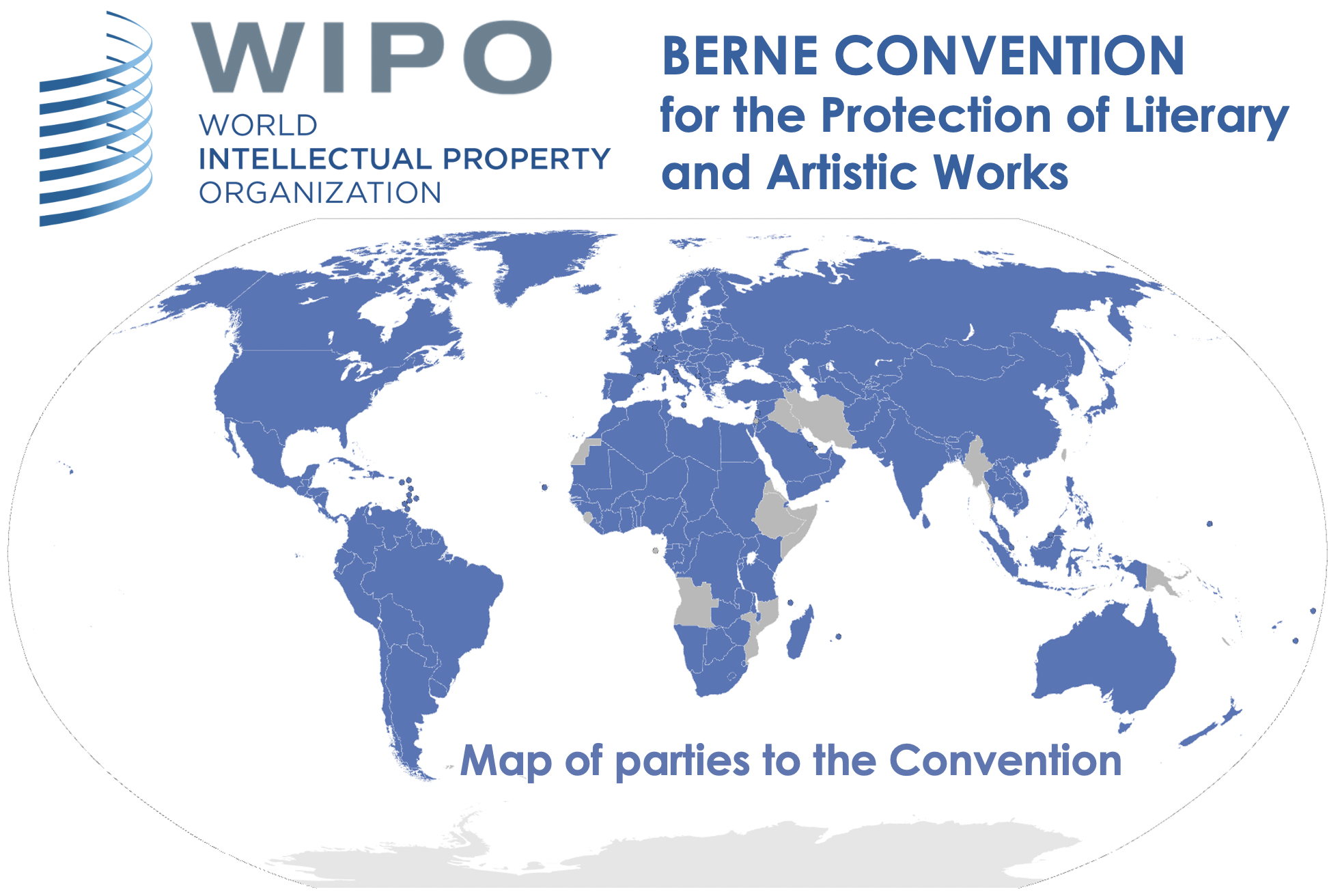
The official link for the authentic text of Berne Convention for the Protection of Literary and Artistic Works (as amended on September 28, 1979) on the website of World Intellectual Property Organization (WIPO): https://www.wipo.int/wipolex/en/treaties/textdetails/12214
Here is the list of law firms, which verification and validation reports (and other legal/expert documents) is considered/recognized by INTEROCO Copyright Office:
|
No. |
Brand Name of Company, Law Firm, Consortium, Group, Partners, etc. |
|
1 |
|
|
2 |
|
|
3 |
|
|
4 |
|
|
5 |
|
|
6 |
|
|
7 |
|
|
8 |
|
|
9 |
|
|
10 |
|
|
11 |
|
|
12 |
|
|
13 |
|
|
14 |
|
|
15 |
|
|
16 |
|
|
17 |
|
|
18 |
|
|
19 |
|
|
20 |
|
|
21 |
|
|
22 |
|
|
23 |
|
|
24 |
|
|
25 |
|
|
26 |
|
|
27 |
|
|
28 |
|
|
29 |
|
|
30 |
|
|
31 |
|
|
32 |
|
|
33 |
|
|
34 |
|
|
35 |
|
|
36 |
|
|
37 |
|
|
38 |
|
|
39 |
|
|
40 |
The vital concern problem in the copyright is not an announcement of the author, because it could be done almost free of charge through sending by author the created work in the sealed envelope by any post services to himself. The practice of sending a copy of your own work to yourself is called a “poor man’s copyright.” There is no provision in international or local copyright laws regarding any such type of protection, and it is not a substitute for registration.
The most important problem during the protection of copyright owner rights (in case of violations and law enforcement) is to provide for official bodies and commercial banks (in case of royalty payments) with a sufficient level of evidentiary form regarding created IP-work.
According to the Berne Convention, the following main requirements are mandatory for implementation by Copyright Offices (information about the full list of requirements could be received from regional authorized operators):
Requirement No. 1. Public access
INTEROCO Copyright Office provides an online link to the deposited item with the public access to this information (on the Internet through a special server storage), which allows to satisfy any reasonable needs of the public in acquaintance with the claimed copyrighted object.
Requirement No. 2. International publication
INTEROCO Copyright Office provides publication of registered copyright work in Germany and country of the application within 2 days after the first approval of an application. According to the requirements of the Berne Convention, for international recognition - a work shall be considered as having been published simultaneously in several countries if it has been published in two or more countries within thirty days of its first publication.
Requirement № 3. Publication after approval of the author
INTEROCO Copyright Office signs (through regional authorized operators) the public agreements with the authors and receives applications where authors confirm the permission for the transfer of work to the depository for registration issues.
The copyright certificates of INTEROCO are recognized in 181 countries of the world (members of Berne Convention). You can deposit anything that is copyrightable: original brands, mobile applications, work of sciences, literary, dramatic, musical, artistic works and video/sound recordings, including novels, poems, lyrics, songs, paintings, drawings, design, computer images, software, advertisements, logos, training materials, and even the rules of a game.
The total number of clients of INTEROCO Copyright Office (from 2014 to 2023) is more than 250k companies (with deposited works more than 3M+) from different countries, including such companies as:
|
IT, Internet, Digital, Web, Crypto, Metaverses |
Apple, Microsoft, Amazon, Alphabet (Google), Facebook, Alibaba, Adobe, Abbott Labs, Salesforce.com, Oracle, Qoovee Trading Platform, SoftLine, SIDUS NFT Metaverse, Farcana Game Metaverse, etc. |
|
Banking, Finance, Insurance |
Visa, Paypal Holdings, Bank of America, Union Insurance, other banks and financial institutions |
| Food, beverage | Coca-Cola, Nestle SA, PepsiCo, Al Ain Water, McDonalds, etc. |
| Machinery, hardware | Tesla, Samsung, AT&T, Verizon Communications, Cisco Systems, Toyota Motors, Mercedes-Benz Group, Siemens AG, Honeywell, Intel, Range Rover, etc. |
| Healthcare, medicine | Novartis, Johnson & Johnson, Roche Holdings, Pfizer, Abu Dhabi Stem Cell Center, etc. |
| Others | Procter & Gamble, L'Oréal France, Walt Disney Co, Arsenal FC, LVMH Moët Hennessy, Nike, KNAUF, Hilton, etc. |
Without deposited copyright work with registered copyright certificates, it is difficult for copyright owners to assert that their materials are original, recorded in evidentiary form and predate other works. We provide a modern depository system allowing the creators to register IP-items with verification, validation and worldwide recognition. After deposition, if the client will pay an extra fee, we will provide a hardcopy of the IP-certificate as proof that we have registered this work his name.
Certificates of INTEROCO Copyright Office are verified and accepted as a legal document by all leading Internet services providers for over the last 10 years (Google, Youtube, AppStore, LinkedIn, Facebook, Twitter, Yahoo, Instagram, TikTok, Google Play, Yandex, Vkontakte, etc.).
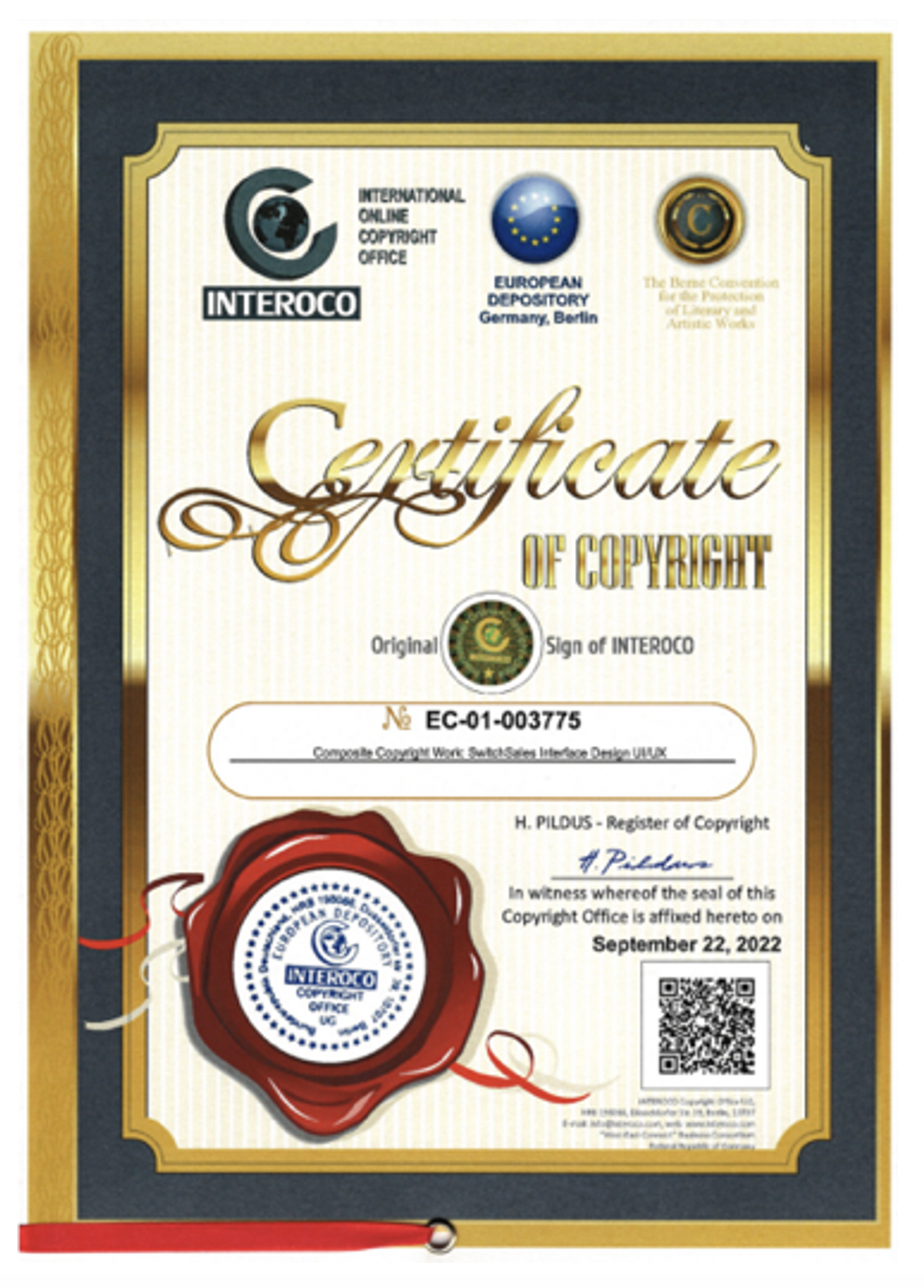
In the event of a dispute, we can support copyright owners with consulting from our experts representing regional authorized operators. Please note - that the Headquarters of INTEROCO Copyright Office in Germany is not working directly with clients, all requests will be transferred to appropriate regional authorized operators of INTEROCO Copyright Office.
All rightsholders of copyright works have a right for:
1. Recognition of authorship throughout the world (in all member-countries of Berne Convention).
2. Prohibition of unfair competition around the world (in all member countries of the Berne Convention).
3. Protection of commercial using of technology, process, methodology.
4. The possibility of capitalization and monetization (on the base of license and franchise agreements, and other IP-tools).
5. Legalization of the use of work of science by the author.
Public references, information and mass media about INTEROCO Copyright Office:
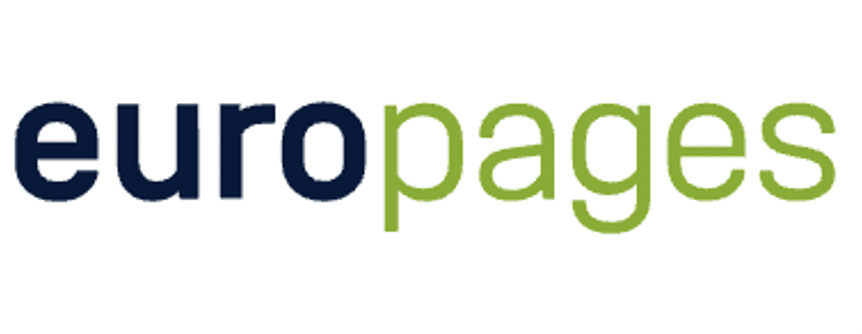
International B2B platform for European Union & UK (europages.co.uk)

Official Government Portal of Germany of Registered Companies
(For verification purposes please enter the company name' INTEROCO' in the field 'Enter company name')
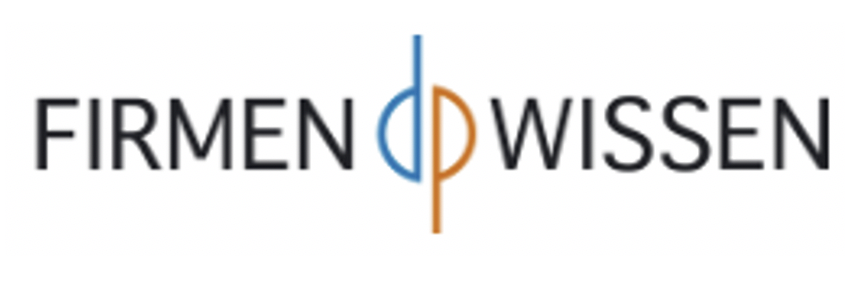
German Portal for Business, KYC/AML, and Credit Information

Global Directory of Commercial Companies

COVID-19 researchers gain IP protection from INTEROCO Copyright Office for COVID-19 new stem-cell treatment
In collaboration with an international IP-Expert - Dr. Sandjar Muminov (from GCC region), INTEROCO Copyright Office provided first in the world registration of NFT as an intellectual property:
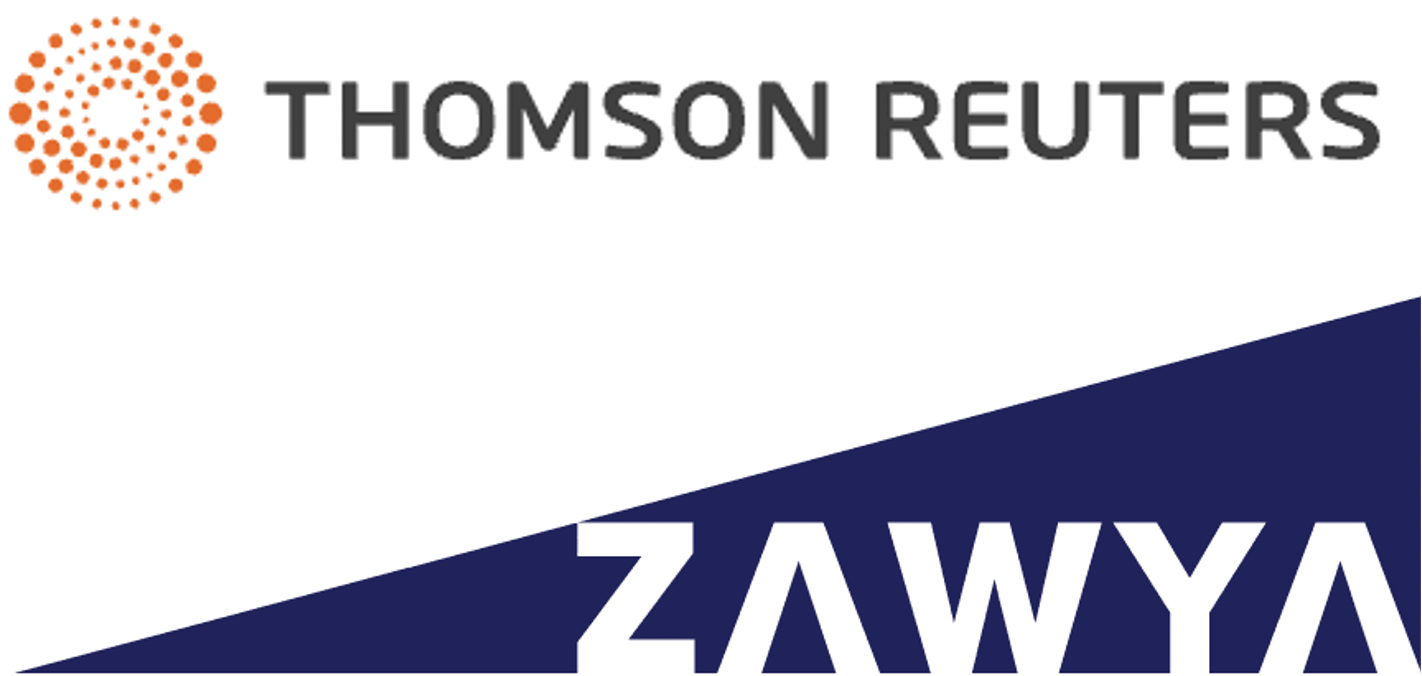
Thomson Reuters Business News Portal, ZAWYA Mass Media by REFIVITIV Financial Markets
In 2015 INTEROCO Copyright Office started accreditation of local expert offices in countries from different regions.
Experts from local offices are providing free-of-charge professional preliminary consultations to explain the meaning and law enforcement possibilities of the international copyright system, verifying IP-works for protectability criteria, and validating authors.
All local regional offices were licensed by INTEROCO Head Office according to the internal INTEROCO standards of the global system of competence, professionalism, and quality control.
Total number of accredited by INTEROCO Copyright Office IP-Experts and IP-Consultants 58 specialists.

